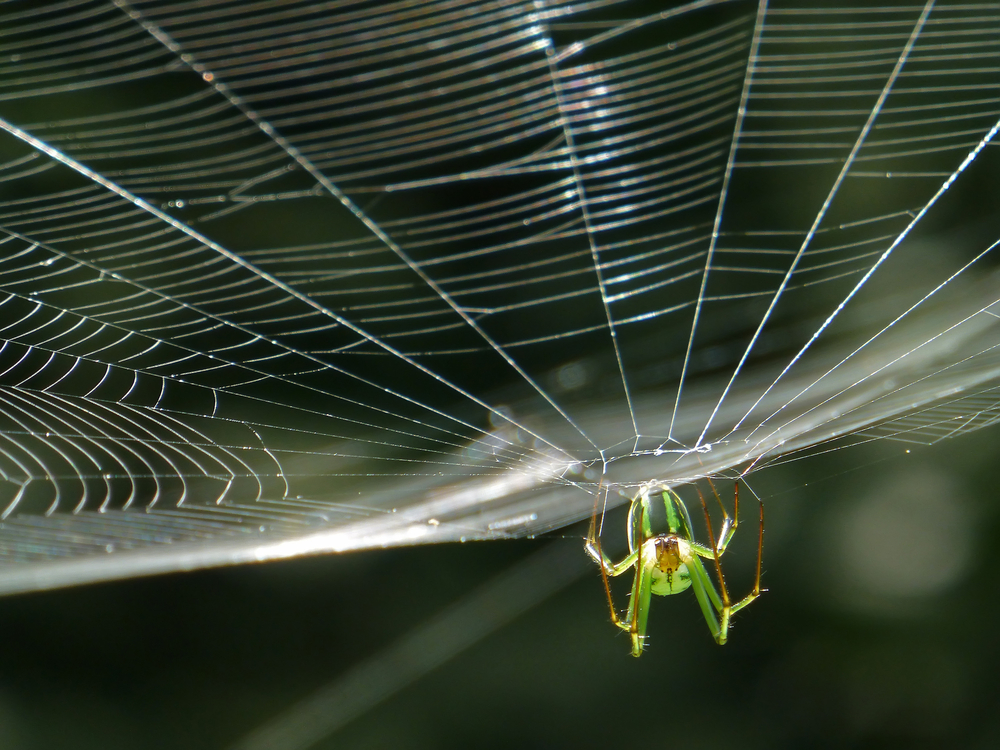
Spiders can custom-produce silk for different applications! This talent has caught the attention of materials scientists worldwide who hope to produce synthetic silk for industrial and consumer products. (Image by Kit Leong/Shutterstock)
This is the time of year when spiders become abundant. Not in the backyard or along the trail, but in shop windows and on houses. Like witches, bats, and black cats, spiders have become associated with the “spooky” Halloween holiday.
I’m all for the festivities, and any holiday where chocolate features prominently is good by me. But, it’s also a great time of year to teach kids that the reputation these creatures have earned for being “scary” is undeserved.
Spiders—The (Not So) Scary Facts
There are a few creatures in the world that we humans seem to instinctively fear. Since spiders fall into this category, it’s not surprising that they earned a spot in Halloween decorations. However, of the approximately 4,000 spider species in the U.S. and Canada, only four groups are known to be harmful to humans—the recluse spiders, the widow spiders, hobo spiders, and yellow sac spiders. Bites are rare and deaths are almost nonexistent.
That said, spiders, like all creatures should be treated with deference and respect. If you are unsure of a species ID, for goodness sake don’t pick it up with your bare hands (more about safe spider observation later) and don’t put your hands or feet (or head for that matter) in places you can’t see into.
Spiders—Cool Stuff
Now that we’ve gotten that out of the way, let’s get to the cool stuff. There are 42,400 known species in the world (and counting). There are spiders that jump, spiders that swim, spiders that drop nets on their prey, and spiders that fish for moths with a line and bait. Spiders can fly (sort of—it’s called ballooning); some can walk on water; some are strikingly beautiful.
Spiders are master hunters. They provide essential insect-control. They are also chemists—spiders can custom-produce silk for different applications! This talent has caught the attention of materials scientists worldwide who hope to produce synthetic silk for industrial and consumer products. And, to top it off, a spider may someday save your life. Current research projects are looking into how compounds in spider venom might be used to treat disease and control pain.
Spider Resources and Books
If I haven’t convinced you to love spiders, I hope you will at least agree they are worthy of a free pass next time you feel the urge to squash one! It’s easy to safely catch a spider for observation (and transportation outside). Place on container (clear, if you want to see it) over it and slide a stiff piece of paper underneath. If you have a handheld magnifying glass, you can let the kids take an up-close look. Ask them how many eyes they can see. The number and arrangement of spider eyes is useful for determining to what family it belongs. Spiders.us has a great chart showing eye arrangements and the corresponding families (http://www.spiders.us/articles/identification/).
There are lots of great kids’ books, both fiction and nonfiction, where spiders are the stars. Of course, Charlotte’s Web, by E.B. White, is the ultimate “spider hero” story. Here are some other suggestions:
Fiction
The Very Patient Spider, by Eric Carle
Aaaarrgghh! Spider, by Lydia Monks
Diary of a Spider, by Doreen Cronin
Anansi the Spider: A Tale from the Ashanti, by Gerald McDermott
Nonfiction
Spiders, by Gail Gibbons
Spiders, by Seymour Simon
Are You a Spider? by Tudor Humphries
Spiders, Kids Discover Magazine
Spiders: Learning to Love Them, by Lynne Kelly (for the grownups)
Spider Crafts
You can make spider decorations with craft supplies you already have around the house. Pompoms, Styrofoam balls, egg carton cups, and even paper cups can be the body. (If you want to be technical, remember spiders have two body sections, the cephalothorax and the abdomen.) Legs can be fashioned from paper, pipe cleaners, craft sticks, or yarn.
Using the same principle, you can make edible spiders as well. Anything round, like sandwich cookies, hamburger buns, crackers, or cupcakes, can be the body. Pretzel sticks, thin licorice, carrot sticks—you get the idea—can be the legs. Candies, chocolate sauce, ketchup, or frosting can all be used to make eyes and other features.
You can also type in “spider activities” into a web search and get a pile of ideas. Here are two I especially liked:
Spider Pop-Up Card (perfect for Halloween cards): http://www.enchantedlearning.com/crafts/halloween/spiderpopupcard/
Spider Web Craft (hey, what could be better than glue AND glitter?): http://www.enchantedlearning.com/crafts/halloween/spiderweb/
